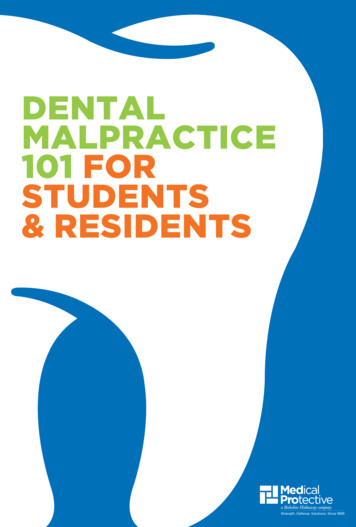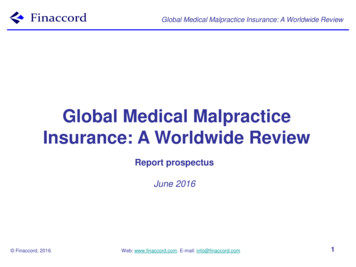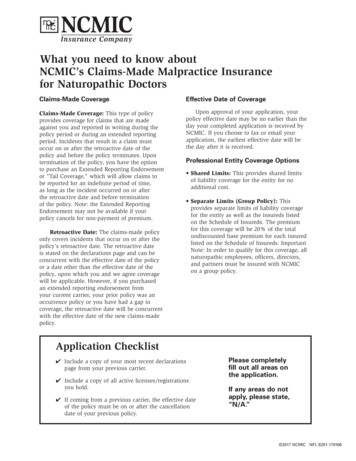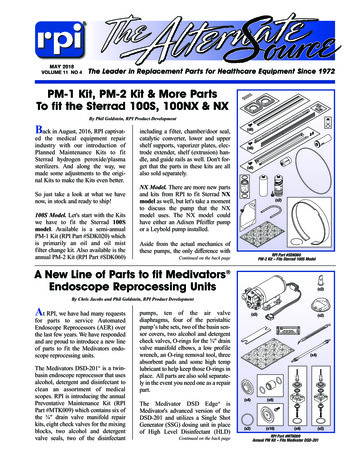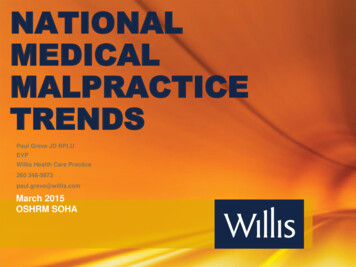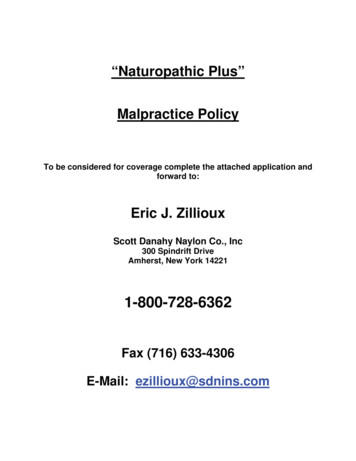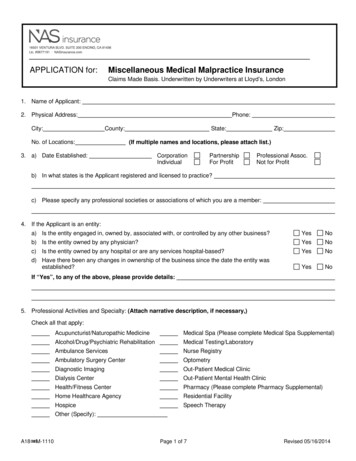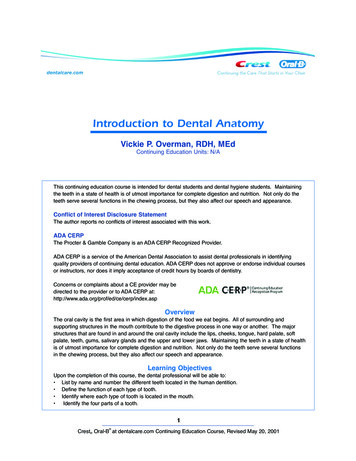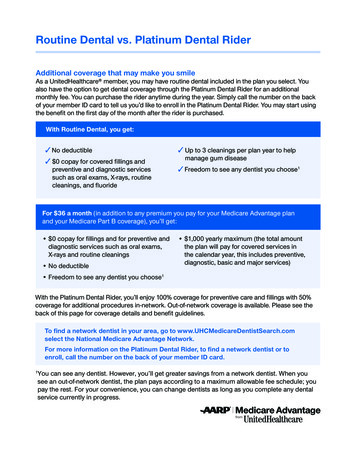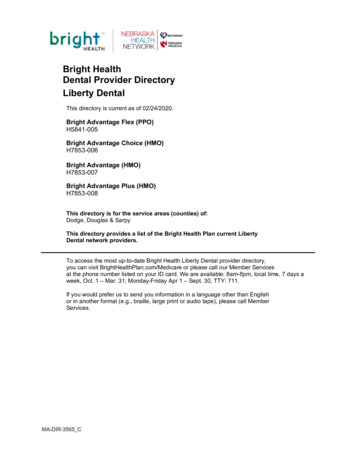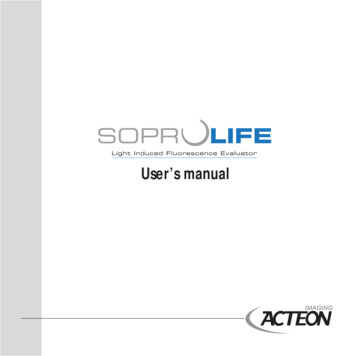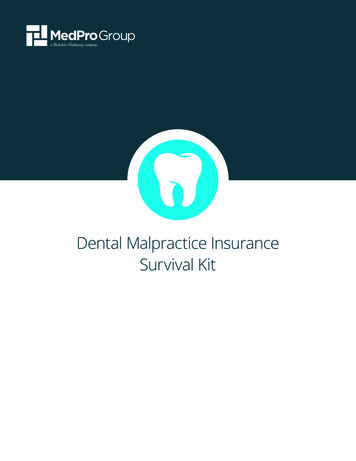
Transcription
Dental Malpractice InsuranceSurvival Kit
This Dental Malpractice Insurance Survival Kit gives you everything youneed to make an informed decision about malpractice insurance, includinga guide to choosing a carrier, instructions on how to obtain insurance, anexplanation of policy types and helpful risk management tips.If you have any questions about the enclosed information, please contact your MedPro representative or agent.Our goal is to help you make an informed decision and to make the selection process easy.So, let’s get started!PG 2 Understanding Dental Malpractice Insurance04Understanding Policy Types06Purchase of Tail08Policy Limits10Patient Compensation Funds12Consent to Settle14Covering Your Practice (Entity Coverage)16Malpractice Claims and Claims Defense17Risk Management18Who is MedPro Group?23Choosing the Right Malpractice Insurance Company26MedPro Group Dental Advisory Board28Malpractice Insurance Glossary30Contact Information33M E D P R O G R O U P D E N TA L M A L P R A C T I C E I N S U R A N C E S U R V I VA L K I T
Stacy had always known shewanted to be a dentist.She worked hard and graduated with honors. She was one of the bestand brightest students. After dental school, Stacy had three job offersand her whole life ahead of her. She moved to a new city, joined agreat practice, bought a home, and was loving her new life.Three years later, Stacy received noticemalpractice insurance. Now she had no waya lawsuit was being filed against her forof knowing whether or not this decisionservices she provided during her first year ofleft her with sufficient coverage or qualitypractice. She was stunned and didn’t knowclaims defense.what to do.This scenario is not uncommon.Unfortunately, Stacy had never read hermalpractice insurance policy in any detail.She really hadn’t understood many of theterms and just assumed the policy musthave the coverage she needed. As manyyoung dentists do, Stacy had allowedsomeone else – her employer – to select herTake the time to research your malpracticeinsurance options and choose the bestcompany, and policy, for you.If you’re reading this handbook, you’realready getting a great head start!D I D YO U KN OW ?Each year, about 3,900 of your future colleagueswill experience a malpractice lawsuit.11Estimated based on the number of reported claims to the NPDB.SPRING 2019 PG 3
Understanding DentalMalpractice InsuranceMalpractice refers to a deviation from the standard of care that resultsin patient injury or death. If it can be proven that a dentist actednegligently, the patient may be able to recover damages through thecivil litigation process to compensate for his or her harm.A dereliction of professional duty or failure to exercise an ordinarydegree of professional skill or learning by one rendering professionalservices which results in injury, loss, or damage.MALPRACTICEA S DEFINED BY MERRIAM-WEBS TERPG 4 M E D P R O G R O U P D E N TA L M A L P R A C T I C E I N S U R A N C E S U R V I VA L K I T
QUIZWhat is the approximate averagepayout in dental malpractice cases?W H AT I SMALPR AC TICE INSUR ANCE?a 10,000A malpractice insurance policy typicallyprovides for both defense costs when amalpractice case is brought forward andindemnification for any damages deemedpayable to the plaintiff.b 35,000c 50,000d 79,000How many dentists experiencea malpractice lawsuit each year?a 1,500WHY DO I NEEDMALPR AC TICE INSUR ANCE?b 3,900Many dentists who haven’t been involvedin a lawsuit think, “This won’t happenc 8,500d 10,000to me,” or “Only bad dentists get sued.”Unfortunately, each year, about 3,900 of yourfuture colleagues experience a malpracticelawsuit. The likelihood of being involved in alawsuit can increase or decrease based onpractice location, the type of practice and theprocedures you perform. On average, thetypical dentist can expect to see one claim inMA JOR MALPR AC TICE VERDIC TSA C R O S S T H E N AT I O N F R O MT H E PA S T 5 Y E A R S .his or her career. 35,000,000As of December 2017, the NationalPractitioner Data Bank (NPDB) shows theaverage dental malpractice payout is about 79,000. 2 This number is limited to the actualindemnity payment to a plaintiff; it does notinclude defense costs, which can be tens ofthousands of dollars.A lawsuit is not necessarily the tool thatmeasures “good” or “bad” dentistry, butthe end result of a malpractice claim can betraumatic, time-consuming and expensive —regardless of the final verdict.Unnecessary root caanals,paid to 29 different patients. 17,500,000Extractions at VA hospital,stroke during procedure. 4,500,000Root canal, overfill of sealerresulting in chronic pain. 3,740,000Extraction and failure todiagnose infection, resulting innecrotizing fascilitis. 2,000,000Caries under crown, impropertreatment resulting in perforated tooth,infection and endocarditis.National Practitioner Data Bank Public Use File,December 31st 2017. Five-year average 2013-2017Claims examples are from news sites andother public records from 2013-2018.answers: 1. D 2. B2SPRING 2019 PG 5
Understanding Policy TypesWhen it comes to malpractice insurance, you have two coverage options:Occurrence or Claims-made. The major difference between the two iswhether coverage is triggered based on when an incident occurs or whenan actual claim is filed.OCCURRENCE COVER AGEOccurrence coverage is triggered the moment dental treatment occurs, regardless of whenan eventual claim is filed.ExampleIf a claim is filed in 2021 based on treatment rendered in 2019, the 2019 Occurrence policy responds.Benefits of Occurrence Coverage A separate set of policy limits is available every year you have Occurrence coverage. This meanspolicy limits stay in place year after year, even after the end of the policy period. There is no reason to purchase “tail coverage” (see next page). When factoring the cost of tail coverage, Occurrence policies are often less expensive thanClaims-made policies.CL AIMS-MADE COVER AGEClaims-made coverage is triggered when the claim is filed. This means that a policy must be in effectwhen the claim is filed.ExampleIf a claim is filed in 2021 based on treatment rendered in 2019, the 2021 Claims-made policy will respondas long as the treatment occurred after the policy’s retroactive date (the date used to mark the beginningof coverage for the insured).Benefits of Claims-made CoverageInitially, Claims-made policies are less expensive than Occurrence policies.PG 6 M E D P R O G R O U P D E N TA L M A L P R A C T I C E I N S U R A N C E S U R V I VA L K I T
201920202021INCIDENT OCCURS IN 2019CL AIM IS MADE IN 20212019 Occurrence Policy Responds2021 Claims-made Policy RespondsTA I L C O V E R A G E ?Because Claims-made coverage is triggered when a claim is filed, these policies do not cover claims filed afterthe termination or cancellation of the policy. To extend coverage you need an extended reporting endorsement(called tail coverage) or your new insurance company must cover your prior acts.Many dentists with Claims-made coverage assume they’ll someday qualify for free tail coverage. But this istypically only upon death, disability or complete retirement. Additionally, some carriers require dentists to be ofa certain age before they can retire and receive free tail. Due to these restrictions, many dentists end up havingto pay for tail out of pocket. Make sure you understand what your policy includes, and what it doesn’t.F O R Y O U R I N F O R M AT I O NTail coverage is generally very expensive. In fact, depending on the state, tailcoverage can cost 160-290% of your current, undiscounted annual Claims-madepremium. Payment is typically due in full and must be paid within 30-60 businessdays after the cancellation or termination of the Claims-made policy.SPRING 2019 PG 7
Common Circumstancesthat Require the Purchase of a TailBOARD COVER AGERESIDENCYL E AV E O F A B S E N C EYou will likely have coverageIf you decide to return to schoolYou may want to terminateoffered to you at no cost forfor a residency program, youcoverage while taking a leaveyour board exam. If this policywill likely be covered by theof absence from practice. If youis not an Occurrence policy, youuniversity. If so, you could cancelhave a Claims-made policy, itwill need tail coverage after theany coverage you have for yourmay require the purchase of tailpolicy’s termination (to cover anycurrent practice. However, if youcoverage. Examples of a leave ofexposures during your boardare insured under a Claims-madeabsence include parental leave,exam). Not having tail coveragepolicy, you will have to purchasepoor health, a sabbatical andmeans not being protected iftail coverage to cover any yearsmedical mission trips.a claim is filed after the policyspent in practice.period expires.Many companies offering Claims-made coverage will advertise “free” tail coverage upon retirement.Ask the company if you are eligible for free tail coverage: If you retire before the age requirement in the policy If you decide to go back to a residency program At the completion of an externship If you take time away from your practice to raise a family or for any other reason If you haven’t been with the carrier for a certain number of years If you decide to join the faculty of a dental school or go into public health prior to retirement If you sell your practice and want to stay with the practice for a couple of years If you have claims experience and are not renewed by your companyPG 8 M E D P R O G R O U P D E N TA L M A L P R A C T I C E I N S U R A N C E S U R V I VA L K I T
R E L O C AT I O NN O N - R E N E WA LIf you move to a state where your insurance companyIf your insurer does not renew your policy, youdoes not offer coverage or where the cost ofmay need to purchase a tail policy to maintainmalpractice insurance is significantly lower than thecoverage for all procedures performed duringoriginal state, you may need to purchase tail coveragethe Claims-made coverage.MOBILITYF A C U LT YAn increasing number of new graduates are joiningWhat if you leave private practice to work forgroup practices. The policies provided are oftena university? In order to ensure coverage forClaims-made, and the average length of employmentprocedures performed during your time spent inwith these organizations is 1.5 to 2 years. 3 You mayprivate practice, you must purchase tail coveragebe required to buy tail coverage when you leave theif you were insured under a Claims-made policy.group, unless your new employer commits to pay fortail coverage in your employment contract or anotherinsurance company covers your prior acts.K E Y TA K E A W AYTo eliminate the complexities involvingtail coverage, you may want to purchasean Occurrence /2014/06/13/from-bungalow-to-big-box/SPRING 2019 PG 9
Policy LimitsPolicy limits are written as two numbers, such as 2 million/ 4 million.The first number reflects what the insurance company will pay perclaim. The second number is the aggregate limit that the company willpay if there are multiple claims in the same policy period.HOW DOES THE T YPE OF COVER AGEA F F E C T TH E P O LI C Y LI M IT S YO U P U R C H A S E E V E RY Y E A R ?Policy limits dictate the maximum amount of money your insurance company will pay on your behalf.How a policy’s limits of liability respond to claims is one of the major distinctions between Occurrenceand Claims-made coverages. The difference between Occurrence and Claims-made policy limitsbecomes even more relevant once the Claims-made coverage is terminated and tail coverage ispurchased or earned.YEARYEAR29 2M 2MYEAROccurrenceOccurrence coverage provides a separate set of limits/ 2M 2M/YEARfor each year you buy the policy, regardless of when 2M 2Mdoesn’t end when the policy terminates. Instead, the 2M 2MYEAR 2Mclaims based upon incidents that occurred during that 2MYEAR 2M 2M 2MClaims-made coverage only provides limits for claims/ 4M3/ 4M 2M/ 4M1 2Mset of limits is available to pay claims arising from allpolicy that offers a standard 2 million/ 4 million policy 2MYEARmade during the current policy year, so only the currentyour previous years of practice. For a Claims-made/ 4MYEAR2Claims-made 2M6/ 4MYEAR/ 4MYEAR5/ 4M15 2M10/ 4MYEAR4policy period. 2M/ 4MYEAR9/ 4M21 2MYEAR/ 4MYEAR8/ 4M 2M28 2MYEAR/ 4M14/ 4MYEAR7limits under the policy remain available to pay future 2M 2MYEAR13/ 4M// 4MOCCURRENCELimits available to you after 35 years ofOccurrence policies. Subject to any payment of claims.limit, only 2 million is available to pay any single claim,and only 4 million total to pay all claims arising during35the span of the policy period.Y R TO TA L 2M/ 4MCLAIMS-MADELimits available to you after 35 years ofClaims-made policies. Subject to any payment of claims.PG 10 M E D P R O G R O U P D E N TA L M A L P R A C T I C E I N S U R A N C E S U R V I VA L K I T/ 4MYEAR 4M20/ 4MYEAR12/ 4M 2M 2M27 2MYEAR19/ 4MYEAR/35/ 4MYEAR 4MYEAR18/ 4M11 2M/ 2M26 2MYEAR34/ 4MYEAR 4MYEAR17/ 4MYEARa claim is made against you. Occurrence coverage/ 2M25 2MYEAR33/ 4MYEAR 4MYEAR16 2M 2M24 4MYEAR32/ 4MYEAR23 4MYEAR31/ 4MYEAR22 2MYEAR30/ 4M/ 4M
D I D YO U KN OW ?Claims-made policies increase in price each year for thefirst 5 years until the rate is “mature,” after which the annualpremium is very close to that of an Occurrence policy.ExampleOver the course of a 35-year career, a generalWith regard to tail coverage, limits maydentist will treat approximately 129,000differ according to the policy provisions.patients, presenting 129,000 opportunitiesFor example, some carriers may setfor a patient to allege malpractice. With tailthe limits of liability for your extendedcoverage, a single set of limits covers thereporting period to the lowest limits youdentist’s career back to the retroactive date.had during any of your last five policyThis means the dentist will have only one setperiods. Be sure to review your policyof limits (for example, 2 million/ 4 million) tofor the limits of liability available for tailpay all potential malpractice claims that arecoverage.4made during the extended reporting period.In contrast, if the same dentist had purchasedOccurrence coverage each year for the same35-year period, he or she would have 35separate sets of limits over the same timespan — one for each policy year.4American Dental Association, Health Policy Institute, Surveys of Dental Practice. Average Number of Patient Visits per Dentist 2017.SPRING 2019 PG 11
Patient Compensation FundsWhat is a Patient’s Compensation Fund, and how does a state-mandatedcap on damages affect policy limits?A number of states have established a Patient’s Compensation Fund (PCF), which is designed to increaseavailability and/or affordability of malpractice insurance. Of those states, Indiana and Louisiana haveunique policy limit options for dentists participating in the PCF.INLAINDIANALOUISIANAPOLICY LIMITSPOLICY LIMITSJuly 2019: 500,000/ 1,500,0002019: 100,000/ 300,000FUND LIMITSFUND LIMITS 1,300,000 400,000INDIANALOUISIANAIn Indiana, your malpractice insuranceIn Louisiana, your malpractice insurancecompany and the PCF work together. Dentistscompany and the PCF work together. Dentistsin Indiana are insured by a malpracticein Louisiana purchase malpractice insuranceinsurance company for 500,000 per claim/with a 100,000 per claim/occurrence limitoccurrence and 1.5 million in the aggregateand 300,000 aggregate limit from anlimit. If you participate in the PCF, you alsoinsurance company. If a claim arises withreceive an additional 1.3 million per claim/damages above these amounts, the PCF willoccurrence from the PCF. Your malpracticeprovide excess coverage up to 400,000, plusinsurance company will submit your PCFmedical expenses. Your malpractice insurancesurcharge to the Indiana PCF.company will submit your PCF surcharge tothe Louisiana PCF.Policy limits as of 7/1/19.PG 12 M E D P R O G R O U P D E N TA L M A L P R A C T I C E I N S U R A N C E S U R V I VA L K I T
A R E T H E R E A N Y O T H E R S TAT E S W I T H L I M I T R E Q U I R E M E N T S ?Yes, many other states require minimum limits of liabilityfor dentists. In some states, minimum limits are notrequired, but maximum damages caps are set.Virginia Cap on Dental Malpractice Damages 2.4M 50KCap per claim as of July 2019Annual cap adjustment untilthe total cap reaches 3 millionH O W D O E S A S TAT E - M A N D AT E D C A PON DAMAGES AF F EC T POLICY LIMITS?For example, in Virginia, the cap on malpractice damagesfor dentists is 2.4 million per claim as of July, 2019. Thecap is adjusted annually by 50,000 until the total capreaches 3 million. Most dentists in Virginia select a limitof liability equal to or greater than the cap of damages.Check with your malpractice company representative orpersonal attorney before choosing a limit of liability.SPRING 2019 PG 13
Consent to SettleYour policy sets forth the rights, duties and obligations of both the insurerand the insured with regard to settlement of a claim. This part of thepolicy is typically called the “consent to settle provision.” You will typicallyfind your consent to settle provision embedded in your malpracticepolicy’s language.A pure consent to settle provision will requireInstead of a pure consent to settle provision,the insurance company to obtain youryou may find exceptions that give allapproval before settling any claim. Thereauthority regarding settlement back to theare no exceptions and no strings attached.insurance company.MedPro Group’s Consent Provision:We will not compromise any claim hereunderwithout the consent of the insured.PG 14 M E D P R O G R O U P D E N TA L M A L P R A C T I C E I N S U R A N C E S U R V I VA L K I T
Marketing material or “company philosophy” may state you have rights,but you should investigate the actual policy language to determine if youhave a pure consent to settle clause.COMMON EXCEP TIONS TO CONS ENT TO S ET TLEMENTUNREASONABLEHAMMER CL AUSEYou have consent authority, unlessIf you refuse to consent to a settlement andthe insurance company deemselect to contest or continue to contest ayou unreasonable in withholdingclaim, the company’s liability for loss shall notyour consent.exceed the amount for which they could havesettled such claim had you consented, plusclaim expenses incurred prior to the time thecompany made such recommendation.B OA R D A P P R OVA LYou have consent authority aslong as the company’s reviewpanel or board agrees with youB I N D I N G A R B I T R AT I O Nthat your performance met theYou have consent authoritystandard of care. If they disagree,unless the company disagrees,the board assumes consentat which time they submitauthority on your behalf.your refusal to consent tobinding arbitration.NO LONGER INSUREDBY T H E C O M PA N YU N AVA I L A B L E O RYou have consent authorityC A N N O T B E L O C AT E Dunless you are no longer insuredYou have consent authority unless theby the company at the timecompany cannot locate you or you aresettlement or trial occurs.otherwise unavailable at the time ofsettlement or jury trial.LICENSE SUSPENDEDYou have consent authorityunless your professional licenseDECEASED ORINCOMPETENThas been suspended, revoked orYou have consent authoritysurrendered at any time duringunless you are deceased orthe claim process.deemed incompetent.SPRING 2019 PG 15
Covering Your Practice(Entity Coverage)It is important to know that, just like you, your practice can be named in amalpractice lawsuit. If you are planning on owning a practice, you shouldconsider two important coverage options: separate limits or shared limits.S E P A R AT E L I M I T S C O V E R A G ES HARED LIMITS COVER AGEIf you own all or a portion of your practice,If you have a solo corporation and have no employed oryou may be eligible for an entity malpractice
This Dental Malpractice Insurance Survival Kit gives you everything you need to make an informed decision about malpractice insurance, including a guide to choosing a carrier, instructions on how to obtain insurance, an expl
